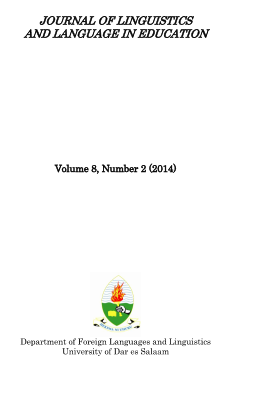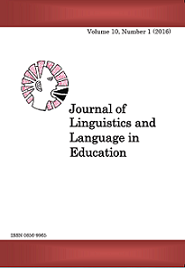An Investigation of Negative Representation in Media: A Case Study of Scrutator
Abstract
The aim of this paper was to investigate negative representation of the National University of Lesotho (henceforth NUL) by the Scrutator in the weekly newspaper, the Lesotho Times. With a view that negative representation is a form of the media framing which seems to be increasingly taking up different dimensions worthy of attention for further conceptual understanding, we set out to examine the phenomenon. We set out with an assumption that the findings of the study would shed light on media operation, in general, and also help the media audiences observe how one of the local print media houses, the Lesotho Times, represents certain groups of Basotho society. The concept of negative representation is probably one of the phenomena which have drawn much attention from scholars of different disciplines within the social sciences, linguistics and communication studies. Adopting Content Analysis as a research instrument in selected issues of the Lesotho Times from 2010 to 2011, we investigated the Scrutator ' s negative representation of the NUL community in this particular newspaper. We, therefore, observe that negative representation is a perspectival projection of the newspaper; it is probably a strategic tool of manipulating people and making them develop a certain attitude towards the University as well as the University community despite its role as a leading tertiary institution in the Kingdom of Lesotho.
Keywords: media production, negative representation, framing, agenda- setting, gate-keeping, manipulation
References
Andersen, E. W. & Olsen, R. K. (1997). Press Freedom and Democracy in Zimbabwe. The Herald and the Daily Gazette: Between the State and the Market IMK Report No. 22.
Bureau of Statistics. (2010). Statistical Yearbook. Maseru, Lesotho.
Cameron, D. (2001). Working with Spoken Discourse. London: Sage Publications.
Dalton-Puffer, C. (2007). Discourse in Content and Language-Integrated Learning. Amsterdam: John Benjamins.
Fourie, P. J. (2001). The Effects and Power of Mass Communication. In P. J. Fourie. (ed.). Media Studies 1: Institutions, Theories and Issues. South Africa: JUTA.
Fourie, P. J. & Karan, B. (2001). Representation: Race, Gender and Orientation. In P. J. Fourie (ed.). Media Studies 1: Institutions, Theories and Issues. South Africa: JUTA.
Fourie, P. J. (2007). Approaches to the Study of Mass Communication. In P. J. Fourie. (ed.). Media Studies, Media History, Media and Society. (2 ed.). Cape Town: JUTA.
Fowler, R. (1991). Language in the News: Discourse and Ideology in the Press. London: Routledge.
Greer, G. (ed.). (2008). Introducing Journalism and Media Studies. Cape Town: JUTA. Gill, S. (1994). A Short History of Lesotho. Morija: Morija Museum and Archives.
Haralambos, M. & Horlborn, M. (1994) Sociology: Themes and Perspectives. (3rd ed.). London: Collins Educational.
Hartley, J. (1982). Understanding News. London: Methuen.
Lesotho. (2010). African Media Barometer: The First Home Grown Analysis of the Media Landscape in Africa. Windhoek: The Media Institute of Southern Africa.
Louw, R. (ed.). (2004).Undue Restriction: Laws Impacting on Media Freedom in the SADC. Windhoek: The Media Institute of Southern Africa.
Malumo, R. & Titus, Z. (eds.). (2010). So This is Democracy? Windhoek: The Media Institute of Southern Africa.
Mcluhan, M. (1969). Understanding Media. London: Sphere Books.
Mouton, J. (2001). How to Succeed in Your Masters and Doctoral Studies. Pretoria: Van Schaik.
National University of Lesotho Calendar. (2006). Morija: Morija Printing Works.
Nisbet, M. C. (n.d.). What is Framing? [http;//sciencebogs.com/framing-science/about.php]. [Accessed 30 November 2009].
Oosthuizen, L. (2001). A Critical Assessment of News. In P. J. Fourie (ed.). Media Studies 1: Institutions, Theories and Issues. South Africa: JUTA.
O ' Shaughnessy, M. & Staddler, J. (2002). Media in Society: An ntroduction. (2nd ed.). Oxford: Oxford University Press.
Oxford Advanced Learner ' s Dictionary. (7th ed.). (2005). Oxford: Oxford University Press.
Steinberg, S. (2007). An Introduction to Communication Studies. Cape Town: JUTA. The ABET Trainer Series. (1997). Learning about English. Cape Town: JUTA.
van Dijk, T.(1987). Communication Racism. London: Academic Press.
van Dijk, T. (1991). Racism and the Press. London: Routledge.
van Dijk, T. (1996). Discourse, Power and Access. In Caldas-Coulthard & Coulthard. 249 €“283.
van Vuuren, D., Maree, A. & De Beer, A. (1998). Mass Media Research: The Question for Knowledge. In A. S. De Beer. (ed.). Mass Media: Towards the Millennium: South African Handbook of Mass Communication. Pretoria: J. L. van Schaik.
Weisfelder, R. F. (1999). Political Contention in Lesotho 1952-1965. Morija: Morija Printing Works.
Wimmer, R. D. & Dominick, J. R. (2006). Mass Media Research: An Introduction. (3rd ed.). Australia: Thomson Wadsworth. Wood, J. T. (2009). Communication in our Lives. Australia: Wadsworth Cengage.
Downloads
Published
Issue
Section
License
Copyright © by Department of Foreign Languages and Linguistics, University of Dar es Salaam
All rights reserved. No part of this publication may be reproduced or transmitted in any form or by any means, electronic or mechanical, including photocopying, recording, or any information storage or retrieval system, without permission in writing from the publisher, except for short extracts in fair dealing, for research or private study, critical scholarly review or discourse with an acknowledgement.



